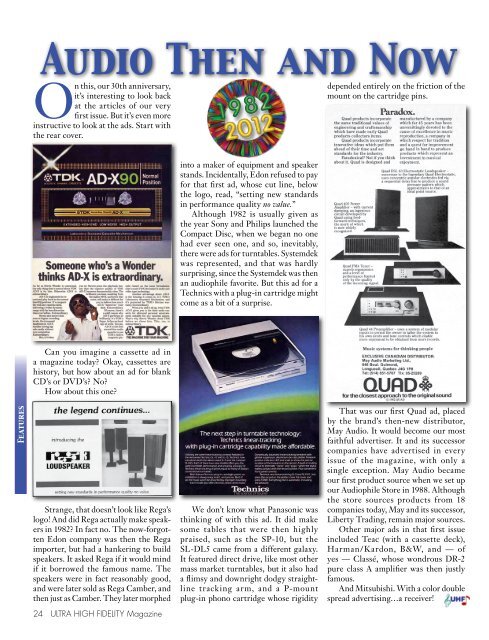USB DONE RIGHT: Two magic boxes that let computer audio ...
USB DONE RIGHT: Two magic boxes that let computer audio ...
USB DONE RIGHT: Two magic boxes that let computer audio ...
You also want an ePaper? Increase the reach of your titles
YUMPU automatically turns print PDFs into web optimized ePapers that Google loves.
On this, our 30th anniversary,<br />
Feedback<br />
Features<br />
Audio Then and Now<br />
it’s interesting to look back<br />
at the articles of our very<br />
first issue. But it’s even more<br />
instructive to look at the ads. Start with<br />
the rear cover.<br />
Can you imagine a cassette ad in<br />
a magazine today? Okay, cassettes are<br />
history, but how about an ad for blank<br />
CD’s or DVD’s? No?<br />
How about this one?<br />
Strange, <strong>that</strong> doesn’t look like Rega’s<br />
logo! And did Rega actually make speakers<br />
in 1982? In fact no. The now-forgotten<br />
Edon company was then the Rega<br />
importer, but had a hankering to build<br />
speakers. It asked Rega if it would mind<br />
if it borrowed the famous name. The<br />
speakers were in fact reasonably good,<br />
and were later sold as Rega Camber, and<br />
then just as Camber. They later morphed<br />
24 ULTRA HIGH FIDELITY Magazine<br />
into a maker of equipment and speaker<br />
stands. Incidentally, Edon refused to pay<br />
for <strong>that</strong> first ad, whose cut line, below<br />
the logo, read, “setting new standards<br />
in performance quality no value.”<br />
Although 1982 is usually given as<br />
the year Sony and Philips launched the<br />
Compact Disc, when we began no one<br />
had ever seen one, and so, inevitably,<br />
there were ads for turntables. Systemdek<br />
was represented, and <strong>that</strong> was hardly<br />
surprising, since the Systemdek was then<br />
an <strong>audio</strong>phile favorite. But this ad for a<br />
Technics with a plug-in cartridge might<br />
come as a bit of a surprise.<br />
We don’t know what Panasonic was<br />
thinking of with this ad. It did make<br />
some tables <strong>that</strong> were then highly<br />
praised, such as the SP-10, but the<br />
SL-DL5 came from a different galaxy.<br />
It featured direct drive, like most other<br />
mass market turntables, but it also had<br />
a flimsy and downright dodgy straightline<br />
tracking arm, and a P-mount<br />
plug-in phono cartridge whose rigidity<br />
depended entirely on the friction of the<br />
mount on the cartridge pins.<br />
That was our first Quad ad, placed<br />
by the brand’s then-new distributor,<br />
May Audio. It would become our most<br />
faithful advertiser. It and its successor<br />
companies have advertised in every<br />
issue of the magazine, with only a<br />
single exception. May Audio became<br />
our first product source when we set up<br />
our Audiophile Store in 1988. Although<br />
the store sources products from 18<br />
companies today, May and its successor,<br />
Liberty Trading, remain major sources.<br />
Other major ads in <strong>that</strong> first issue<br />
included Teac (with a cassette deck),<br />
Harman/Kardon, B&W, and — of<br />
yes — Classé, whose wondrous DR-2<br />
pure class A amplifier was then justly<br />
famous.<br />
And Mitsubishi. With a color double<br />
spread advertising…a receiver!
















